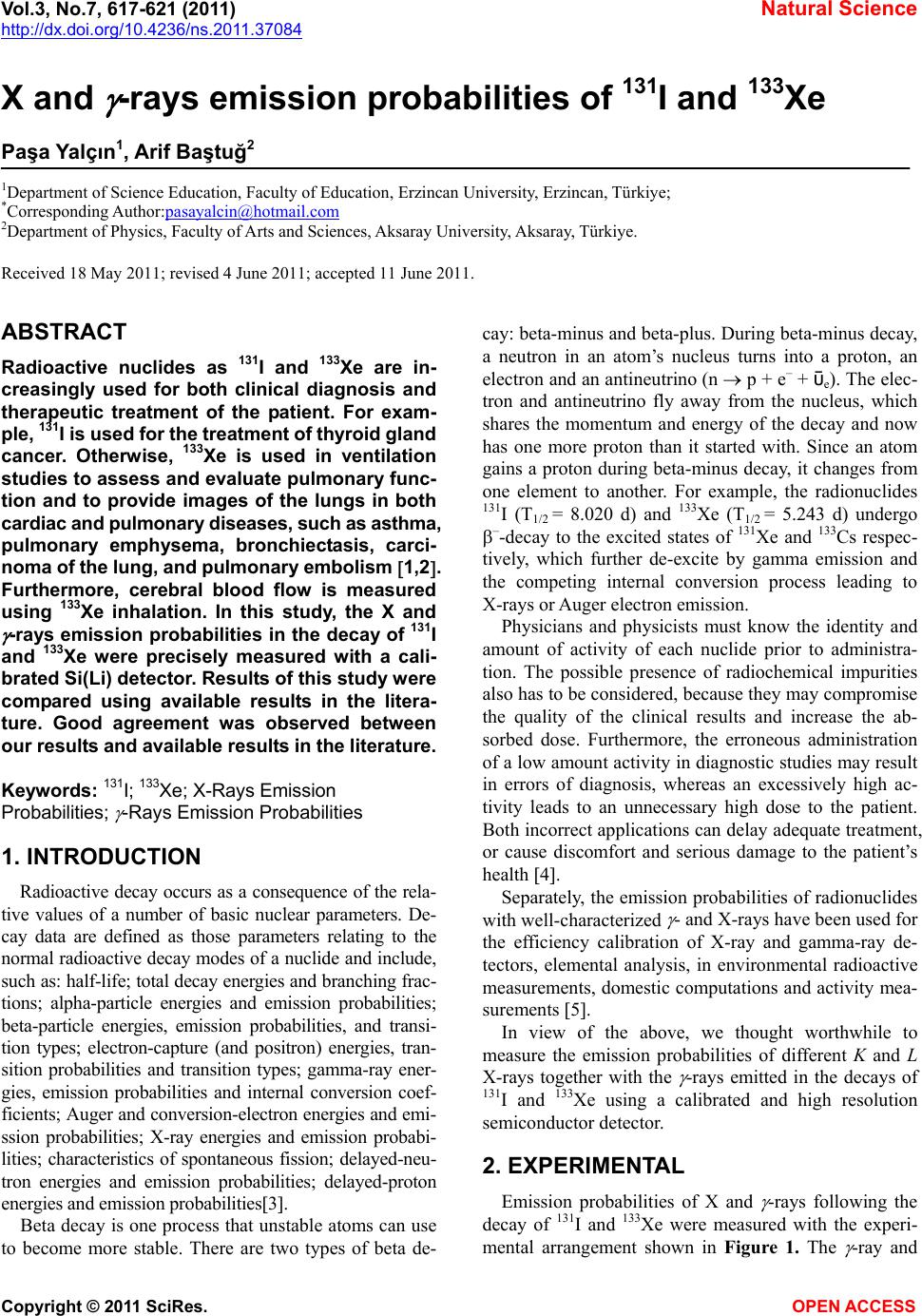
Vol.3, No.7, 617-621 (2011) Natural Science
http://dx.doi.org/10.4236/ns.2011.37084
Copyright © 2011 SciRes. OPEN ACCESS
X and
-rays emission probabilities of 131I and 133Xe
Paşa Yalçın1, Arif Baştuğ2
1Department of Science Education, Faculty of Education, Erzincan University, Erzincan, Türkiye;
*Corresponding Author:pasayalcin@hotmail.com
2Department of Physics, Faculty of Arts and Sciences, Aksaray University, Aksaray, Türkiye.
Received 18 May 2011; revised 4 June 2011; accepted 11 June 2011.
ABSTRACT
Radioactive nuclides as 131I and 133Xe are in-
creasingly used for both clinical diagnosis and
therapeutic treatment of the patient. For exam-
ple, 131I is used for the treatment of thyroid gland
cancer. Otherwise, 133Xe is used in ventilation
studies to assess and evaluate pulmonary func-
tion and to provide images of the lungs in both
cardiac and pulmonary diseases, such as asthma,
pulmonary emphysema, bronchiectasis, carci-
noma of the lung, and pulmonary embolism 1,2.
Furthermore, cerebral blood flow is measured
using 133Xe inhalation. In this study, the X and
-rays emission probabilities in the decay of 131I
and 133Xe were precisely measured with a cali-
brated Si(Li) detector. Results of this study were
compared using available results in the litera-
ture. Good agreement was observed between
our results and available results in the literature.
Keyw ords: 131I; 133Xe; X-Rays Emission
Probabilities;
-Rays Emission Probabilities
1. INTRODUCTION
Radioactive decay occurs as a consequence of the rela-
tive values of a number of basic nuclear parameters. De-
cay data are defined as those parameters relating to the
normal radioactive decay modes of a nuclide and include,
such as: half-life; total decay energies and branching frac-
tions; alpha-particle energies and emission probabilities;
beta-particle energies, emission probabilities, and transi-
tion types; electron-capture (and positron) energies, tran-
sition probabilities and transition types; gamma-ray ener-
gies, emission probabilities and internal conversion coef-
ficients; Auger and conversion-electron energies and emi-
ssion probabilities; X-ray energies and emission probabi-
lities; characteristics of spontaneous fission; delayed-neu-
tron energies and emission probabilities; delayed-proton
energies and emission probabilities3.
Beta decay is one process that unstable atoms can use
to become more stable. There are two types of beta de-
cay: beta-minus and beta-plus. During beta-minus decay,
a neutron in an atom’s nucleus turns into a proton, an
electron and an antineutrino (n p + e– + ῡe). The elec-
tron and antineutrino fly away from the nucleus, which
shares the momentum and energy of the decay and now
has one more proton than it started with. Since an atom
gains a proton during beta-minus decay, it changes from
one element to another. For example, the radionuclides
131I (T1/2 = 8.020 d) and 133Xe (T1/2 = 5.243 d) undergo
–-decay to the excited states of 131Xe and 133Cs respec-
tively, which further de-excite by gamma emission and
the competing internal conversion process leading to
X-rays or Auger electron emission.
Physicians and physicists must know the identity and
amount of activity of each nuclide prior to administra-
tion. The possible presence of radiochemical impurities
also has to be considered, because they may compromise
the quality of the clinical results and increase the ab-
sorbed dose. Furthermore, the erroneous administration
of a low amount activity in diagnostic studies may result
in errors of diagnosis, whereas an excessively high ac-
tivity leads to an unnecessary high dose to the patient.
Both incorrect applications can delay adequate treatment,
or cause discomfort and serious damage to the patient’s
health 4.
Separately, the emission probabilities of radionuclides
with well-characterized
- and X-rays have been used for
the efficiency calibration of X-ray and gamma-ray de-
tectors, elemental analysis, in environmental radioactive
measurements, domestic computations and activity mea-
surements 5.
In view of the above, we thought worthwhile to
measure the emission probabilities of different K and L
X-rays together with the
-rays emitted in the decays of
131I and 133Xe using a calibrated and high resolution
semiconductor detector.
2. EXPERIMENTAL
Emission probabilities of X and
-rays following the
decay of 131I and 133Xe were measured with the experi-
mental arrangement shown in Figure 1. The
-ray and